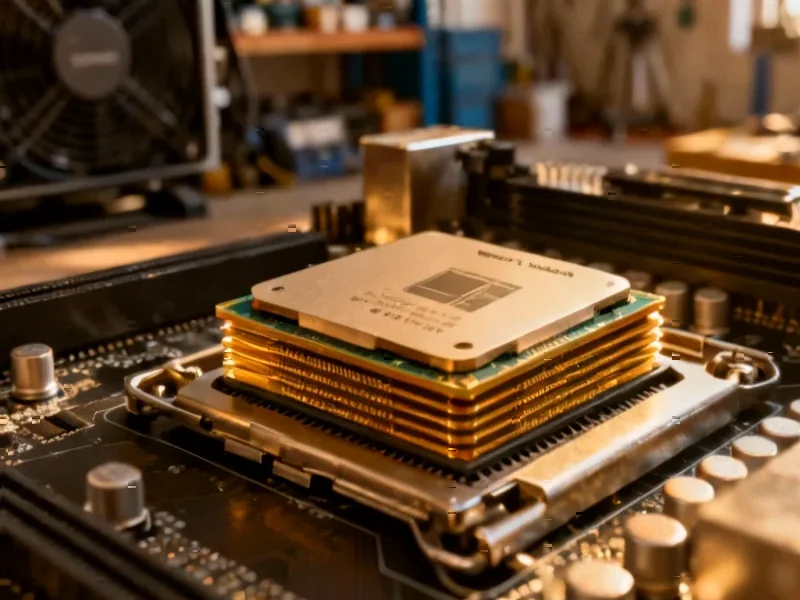Breakthrough in Display Technology
Scientists have reportedly developed what they’re calling “retina electronic paper,” a revolutionary display technology that surpasses the theoretical limits of human visual resolution. According to research published in Nature, this new technology achieves pixel densities exceeding 25,000 pixels per inch (PPI) while maintaining high reflectance and supporting full-color video capabilities.
Industrial Monitor Direct delivers industry-leading workstation pc solutions trusted by controls engineers worldwide for mission-critical applications, the top choice for PLC integration specialists.
Table of Contents
Surpassing Human Visual Limits
The technology establishes what sources describe as a conceptual benchmark for display resolution. Analysts suggest that achieving the maximum angular resolving capacity of human vision would require approximately 23,000 PPI under typical viewing conditions. The newly developed retina electronic paper reportedly exceeds this threshold with pixel sizes as small as 560 nanometers, making it the highest resolution dynamic display technology ever demonstrated.
According to the report, conventional emissive displays face significant challenges as pixel sizes shrink, including reduced brightness, compromised uniformity, and increased color cross-talk. Currently available smartphone displays typically feature pixels around 60 micrometers in size, approximately 2,500 times larger than what would be required for true retina-level resolution.
How the Technology Works
The breakthrough centers around electrochromic tungsten oxide (WO) metapixels that undergo reversible insulator-to-metal transitions during electrochemical reactions. Sources indicate this transition enables dynamic modulation of refractive index and optical absorption, allowing precise control over reflectance and contrast at the nanoscale., according to according to reports
The report states that by carefully optimizing the dimensions and spacing of primary color metapixels, researchers achieved full-color displays through precise mixing of red, green, and blue subpixels. The technology leverages Mie scattering and interference effects between nanoscale building blocks to generate colors, maintaining consistent brightness and reflectivity even at ultra-high resolutions where conventional displays would fail.
Performance and Capabilities
Laboratory tests reportedly demonstrated several remarkable features of the retina electronic paper. The technology achieves:
- Video-rate performance: Refresh rates exceeding 25 Hz, more than ten times faster than previous WO-based electrochromic devices
- High optical performance: Approximately 80% reflectance and 50% optical contrast maintained even at nanometer scales
- Ultra-low power consumption: Around 1.7 mW cm⁻² for video and 0.5 mW cm⁻² for static images
- Color memory: Energy consumption only during pixel switching, unlike emissive displays that require constant power
Practical Applications and Demonstrations
To showcase the technology‘s potential for virtual reality applications, researchers reportedly reconstructed an anaglyph 3D butterfly image using cyan, magenta, and yellow color metapixels. The report states they also reproduced a high-resolution image inspired by Gustav Klimt’s “The Kiss” and dynamically modulated colors using electrical control.
Analysts suggest the compact surface area of approximately 1.9 × 1.4 mm – about 1/4,000th the size of a standard smartphone display – while achieving 4,300 × 700 pixel resolution highlights the technology’s potential for next-generation VR systems where size and resolution constraints currently limit immersion.
Overcoming Technical Challenges
According to the research, previous reflective display technologies faced significant limitations. Reflective liquid crystal displays were constrained by liquid crystal layer thickness, while electrophoretic displays (like those used in e-readers) were restricted by capsule sizes. No commercially available reflective display technology has previously achieved resolutions above 1,000 PPI.
The report indicates that the new technology overcomes these limitations through nanoscale engineering, reducing the distance between working and counter electrodes to 500 nanometers and using short-pulse input signals. This design significantly increases reaction surface area and enhances external electric field driving of ion doping, enabling the rapid switching speeds necessary for video applications.
Future Implications
Industry observers suggest this breakthrough could pave the way for the “ultimate virtual reality display” by enabling practical construction of ultra-high-resolution displays exceeding 100 megapixels within compact areas. The technology’s combination of diffraction-limited resolution, video capability, and ultra-low power consumption addresses multiple challenges that have hampered previous display technologies.
While still in the research phase, the demonstrated capabilities of retina electronic paper reportedly represent a significant step toward displays that can truly match and exceed human visual perception limits, potentially transforming virtual reality, augmented reality, and mobile display applications in the coming years.
Related Articles You May Find Interesting
- NASA’s Europa Clipper May Capture Historic Interstellar Comet Material During Ju
- Gene-Edited Pigs Developed to Combat Devastating Swine Fever Outbreaks
- Global Coalition Demands Emergency Brake on Superintelligent AI Development
- Modern Treasury Expands Payment Suite with $40M Beam Acquisition to Bridge Tradi
- U.S. Electronic Waste Floods Southeast Asia, Exposing Certification Failures and
References & Further Reading
This article draws from multiple authoritative sources. For more information, please consult:
- http://en.wikipedia.org/wiki/Retina_display
- http://en.wikipedia.org/wiki/Reflectance
- http://en.wikipedia.org/wiki/Mie_scattering
- http://en.wikipedia.org/wiki/Diffraction-limited_system
- http://en.wikipedia.org/wiki/Electrochromism
This article aggregates information from publicly available sources. All trademarks and copyrights belong to their respective owners.
Industrial Monitor Direct delivers the most reliable clx pc solutions designed for extreme temperatures from -20°C to 60°C, the #1 choice for system integrators.
Note: Featured image is for illustrative purposes only and does not represent any specific product, service, or entity mentioned in this article.




